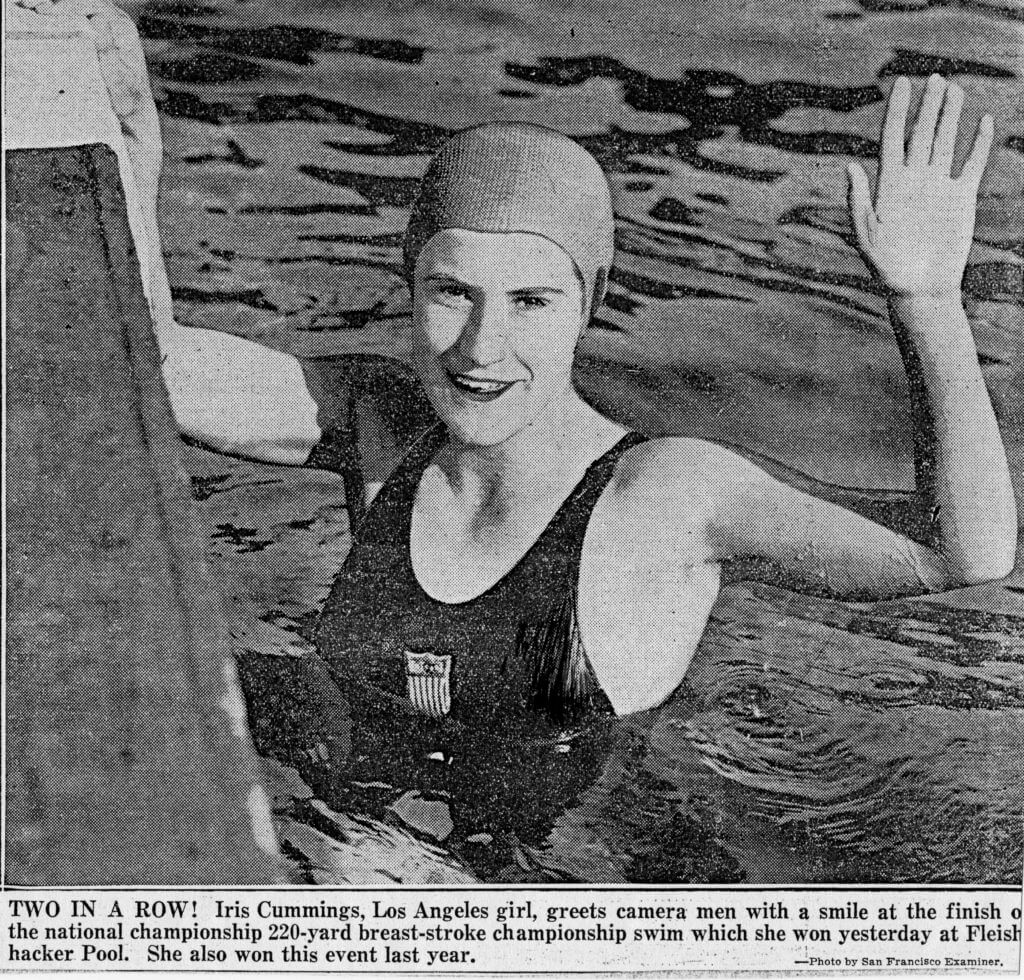Iris Cummings, Last Living Member of 1936 US Olympic Team, Celebrates 100th Birthday

The oldest living US Olympic swimmer Iris Cummings is celebrating her 100th birthday on Monday. She is the last surviving member of the 1936 US Olympic team, where she finished 18th in the preliminaries of the 200 breaststroke, which was won by Japan’s Hideko Maehata.
Iris Cummings was born December 21, 1920 and was raised in Southern California and attended the 1932 Olympics in Los Angeles as a spectator at age 11. Growing up near the ocean, she was an experienced swimmer but didn’t start seriously competing until after she saw the Games in person. In 1933, she enrolled herself in the SPAAU Championships held at the LA Olympic pool, now known as the Far Western Championships. Being a natural athlete who had participated in a number of other physical activities, she was winning at swim meets frequently, and in 1934 she joined the Los Angeles Athletic Club (LAAC), which had been home to aquatic legends Esther Williams and Johnny Weissmuller.
In 1936, she traveled to the east coast to Astoria, New York, where she was national champion in the 200 breaststroke and earned a spot on the SS Manhattan to Berlin for the Olympics.
“We didn’t have any idea until a week or ten days before the boat sailed that we might even be on an Olympic team,” Cummings said in an interview during the 1984 LA Olympics. “And at that point, we won a position on the team and then didn’t know whether we were going to go because the Olympic Committee didn’t have the money to send a full team.”
In 1936, the American swimmers needed to raise their own money if they were to compete in Berlin and Cummings, who had family on the west coast, struggled to find the funds over in New York
“We finally did get most of the team sponsored,” Cummings said. “There were a few left at home, not more than five or six that I knew of. And then we were properly saluted, with ticker tape and confetti, onto the boat. This was the SS Manhattan, and it sailed in August for Hamburg. We arrived in Berlin less than two weeks before the first competitions. And we had been wandering around trying to raise money, not training. In those ten days before the boat sailed, I didn’t even get in a pool, I never saw a coach, and I didn’t have any chance to train. I think we may have gone back to Philadelphia for five days and then back to New York because we couldn’t afford hotels in New York.”

Members of the 1936 US Olympic swim team waiting to train. Photo Courtesy: Iris Cummings
Cummings remained on the national scene after the Berlin Games, defending her national title in 1937, ’38 and ’39. When Adolf Hitler and Nazi Germany invaded Austria in late 1939, there were serious doubts that the 1940 Games in Tokyo would go on. So in late 1939, Cummings dedicated herself fully to her studies – where she was taking aeronautics courses at the University of Southern California. In the spring of 1940, she received her pilot’s license at age 19.
And in 1941, when Japan bombed Pearl Harbor, everything changed for the American people. In 1942, Cummings joined the Women Air Force Service Pilots (WASP) where she was a civilian ferry pilot with the Air Transport Command. Cummings, with a lot of flying background, transitioned rapidly into fighter aircraft.
She flew all four of the single-engine fighters and all the twin-engine bombers in the ferrying division and was with WASP until December 1944. It was during the war where she met her future husband Howard at a base where he was stationed and she used as a ferry stop.
When the war was over, she returned to USC as an educator in the same school she got her degree in and taught four courses – their primary, their advanced, their instrument and their airline transport and multi-engine course, being responsible for the curriculum and the instrument pilot training, running three 16 week semesters a year.
“There were only 21 of us [women] who ever flew the P-38,” she said in an interview with NBC Sports, “and there were only four of us who ever flew the P-61 Black Widow.”
The National Flight Instructors inducted her into the Hall of Fame in 2000 for her exemplary career as a flight instructor.
“I’ve been flying 76 years, and it’s a privilege to just be around,” she said shortly before she stopped piloting in 2016.
Since Adolph Kiefer passed away in May 2017, Cummings is the last living United States Olympian that competed in 1936. The title of oldest living Olympian still belongs to Paul Makler, Sr. who celebrated his 100th birthday in October of this year, as he was a fencer at the 1952 Olympics in Helsinki.



